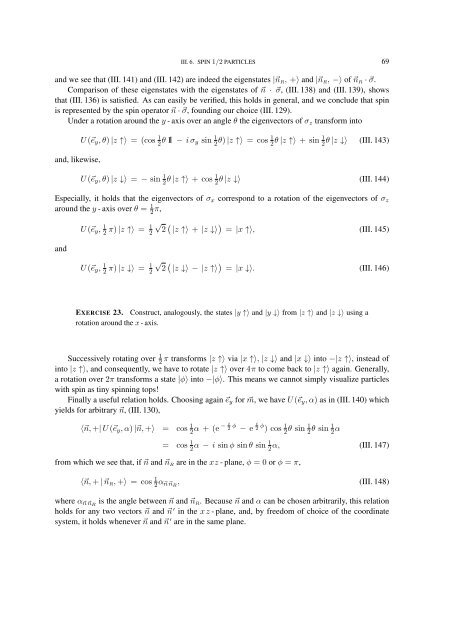FOUNDATIONS OF QUANTUM MECHANICS
FOUNDATIONS OF QUANTUM MECHANICS
FOUNDATIONS OF QUANTUM MECHANICS
Create successful ePaper yourself
Turn your PDF publications into a flip-book with our unique Google optimized e-Paper software.
III. 6. SPIN 1/2 PARTICLES 69<br />
and we see that (III. 141) and (III. 142) are indeed the eigenstates |⃗n R , +⟩ and |⃗n R , −⟩ of ⃗n R · ⃗σ.<br />
Comparison of these eigenstates with the eigenstates of ⃗n · ⃗σ, (III. 138) and (III. 139), shows<br />
that (III. 136) is satisfied. As can easily be verified, this holds in general, and we conclude that spin<br />
is represented by the spin operator ⃗n · ⃗σ, founding our choice (III. 129).<br />
Under a rotation around the y - axis over an angle θ the eigenvectors of σ z transform into<br />
and, likewise,<br />
U (⃗e y , θ) |z ↑⟩ = (cos 1 2 θ 11 − i σ y sin 1 2 θ) |z ↑⟩ = cos 1 2 θ |z ↑⟩ + sin 1 2θ |z ↓⟩ (III. 143)<br />
U (⃗e y , θ) |z ↓⟩ = − sin 1 2 θ |z ↑⟩ + cos 1 2θ |z ↓⟩ (III. 144)<br />
Especially, it holds that the eigenvectors of σ x correspond to a rotation of the eigenvectors of σ z<br />
around the y - axis over θ = 1 2 π,<br />
and<br />
U (⃗e y , 1 2 π) |z ↑⟩ = 1 2<br />
√<br />
2<br />
(<br />
|z ↑⟩ + |z ↓⟩<br />
)<br />
= |x ↑⟩, (III. 145)<br />
U (⃗e y , 1 2 π) |z ↓⟩ = 1 2<br />
√<br />
2<br />
(<br />
|z ↓⟩ − |z ↑⟩<br />
)<br />
= |x ↓⟩. (III. 146)<br />
EXERCISE 23. Construct, analogously, the states |y ↑⟩ and |y ↓⟩ from |z ↑⟩ and |z ↓⟩ using a<br />
rotation around the x - axis.<br />
Successively rotating over 1 2<br />
π transforms |z ↑⟩ via |x ↑⟩, |z ↓⟩ and |x ↓⟩ into −|z ↑⟩, instead of<br />
into |z ↑⟩, and consequently, we have to rotate |z ↑⟩ over 4π to come back to |z ↑⟩ again. Generally,<br />
a rotation over 2π transforms a state |ϕ⟩ into −|ϕ⟩. This means we cannot simply visualize particles<br />
with spin as tiny spinning tops!<br />
Finally a useful relation holds. Choosing again ⃗e y for ⃗m, we have U (⃗e y , α) as in (III. 140) which<br />
yields for arbitrary ⃗n, (III. 130),<br />
⟨⃗n, +| U (⃗e y , α) |⃗n, +⟩ = cos 1 2 α + (e − i 2 ϕ − e i 2 ϕ ) cos 1 2 θ sin 1 2 θ sin 1 2 α<br />
= cos 1 2 α − i sin ϕ sin θ sin 1 2α, (III. 147)<br />
from which we see that, if ⃗n and ⃗n R are in the xz - plane, ϕ = 0 or ϕ = π,<br />
⟨⃗n, + | ⃗n R , +⟩ = cos 1 2 α ⃗n ⃗n R<br />
, (III. 148)<br />
where α ⃗n ⃗nR is the angle between ⃗n and ⃗n R . Because ⃗n and α can be chosen arbitrarily, this relation<br />
holds for any two vectors ⃗n and ⃗n ′ in the xz - plane, and, by freedom of choice of the coordinate<br />
system, it holds whenever ⃗n and ⃗n ′ are in the same plane.
















